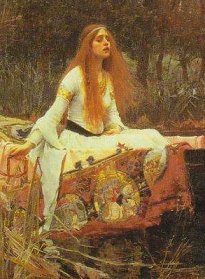In The Lady of Shalott (1888) John William Waterhouse depicts a scene from the final section of Tennyson’s poem, Part IV. This painting shows the Lady wearing a white dress and sitting in a boat on a river. She looks pitiful and is surrounded by beautifully detailed throws or coverings.
Resigned to Death
Unlike his other paintings on this subject set in her prison-like room, she is out in the open. Still, however, she seems trapped but this time she is trapped by her fate. Her mouth is open as she sings, and she looks resigned to the death dictated by her curse.
Like some Bold Seër in a Trance
This painting differs from Tennyson’s description more so than the others. Tennyson has her going to the boat as ‘the stormy east-wind strain[s] / The pale yellow woods’ and ‘The broad stream in his banks complaining’ (lines 118-120). Meanwhile, Waterhouse depicts her floating down a fairly placid stream in gloomy, but not stormy weather.
Waterhouse does, however capture the same attitude from the Lady that Tennyson describes. The speaker says she is
Like some bold seër in a trance,
Seeing all his own mischance-
With a glassy countenance
Did she look to Camelot. (lines 128-131)
In Waterhouse’s painting she is looking off in the distance, but like someone in a trance does not seem to focus on anything. Her sad expression is very like one who has seen ‘his own mischance’ as she looks in the direction of Camelot.

Quietly Slipes from Life?
Both artists depict her in a ‘snowy white’ gown (line 136). However, Tennyson describes her as lying in the boat (line 136) while Waterhouse depicts her sitting up right as she ‘sing[s] her last song’ (line 143). In Tennyson’s poem she quietly slips from life to death and when her song stops, she dies. As depicted in Waterhouse’s painting, this transition could not be so smooth.
"She has a lovely face . . . "
Waterhouse did not produce a painting of the scene when the Lady reaches Camelot. Tennyson’s speaker explains that ‘ere she reach'd upon the tide / The first house by the water-side, / Singing in her song she died’ (lines 150-152). Thus, the Lady’s body in her boat silently floats into Camelot where it is found by ‘Knight and burgher, lord and dame’ (line 160).
Only Lancelot does not respond in fear to her body; the others
cross'd themselves for fear,
All the knights at Camelot:
But Lancelot mused a little space;
He said, "She has a lovely face;
God in his mercy lend her grace,
The Lady of Shalott". (lines 166-171)
Just as the Lady determines from the way he looks that he is worthy of her sacrifice, he looks at her beauty and prays she will find grace.
Over the last three weeks as I’ve worked through this longish poem, I’ve focused on the scenes depicted by Waterhouse in his three paintings of the Lady. Tennyson’s poem and its subject have inspired many painters over the years. You’ll find a gallery of Lady of Shallot paintings here. Which paintings are your favourites?